实际400 kV换流变压器中溶解气体扩散特性的研究——故障类型的影响
IF 3.1
3区 工程技术
Q2 ENGINEERING, ELECTRICAL & ELECTRONIC
IEEE Transactions on Dielectrics and Electrical Insulation
Pub Date : 2025-03-10
DOI:10.1109/TDEI.2025.3549714
引用次数: 0
摘要
溶解气体分析(DGA)技术是监测大型油浸变压器的关键方法。然而,大容量变压器体积大、结构复杂、气体扩散路径长,使得故障产生的气体在变压器内部的扩散特性不明确,限制了DGA技术的检测精度。本文研究了±400kv换流变压器中溶解气体在不同故障类型下的扩散特性,并分析了扩散过程中不同监测点气体浓度的时间变化。结果表明,油流速度是影响变压器内溶解气体扩散的主要因素。故障气体的浓度虽然不影响溶解气体在变压器内的扩散路径,但会影响扩散速率。此外,换流变压器交流侧转塔处的油流循环缓慢且有方向性,阻碍了变压器油中溶解气体的扩散,从而阻碍了故障的及时检测。本研究结果为现场换流变压器中溶解气体监测装置的安装和最佳监测周期间隔的确定提供了重要的见解。本文章由计算机程序翻译,如有差异,请以英文原文为准。
Investigation on the Diffusion Characteristics of Dissolved Gas in an Actual 400 kV Converter Transformer—Effects of Fault Types
The dissolved gas analysis (DGA) technology is a key method for monitoring large oil-immersed transformers. However, the large size, complex structure, and extended gas diffusion paths of high-capacity transformers make the diffusion characteristics of fault-generated gases within the transformer unclear, which limits the detection accuracy of DGA technology. This article investigates the diffusion characteristics of dissolved gases in a ±400 kV converter transformer under various fault types and analyzes the temporal changes in gas concentration at different monitoring points during the diffusion process. The results show that oil flow velocity is the primary factor influencing the diffusion of dissolved gases in the transformer. Although the concentration of fault gases does not affect the diffusion path of dissolved gases in the transformer, it does influence the diffusion rate. Moreover, the oil flow circulation at the turret on the ac side of the converter transformer is slow and directional, which impedes the diffusion of dissolved gases in the transformer oil, thereby hindering timely fault detection. The results of this study offer significant insights for the installation of dissolved gas monitoring devices in field converter transformers and the determination of the optimal monitoring cycle interval.
求助全文
通过发布文献求助,成功后即可免费获取论文全文。
去求助
来源期刊
CiteScore
6.00
自引率
22.60%
发文量
309
审稿时长
5.2 months
期刊介绍:
Topics that are concerned with dielectric phenomena and measurements, with development and characterization of gaseous, vacuum, liquid and solid electrical insulating materials and systems; and with utilization of these materials in circuits and systems under condition of use.

 求助内容:
求助内容: 应助结果提醒方式:
应助结果提醒方式:


